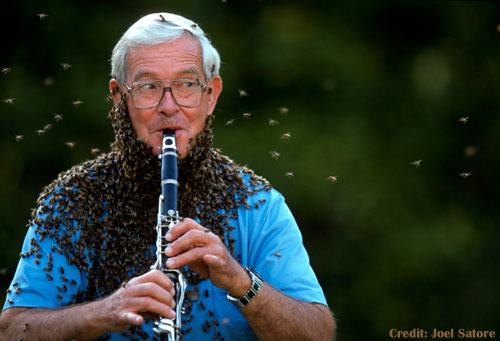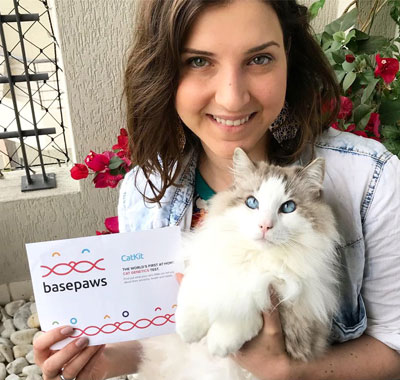Bee Wrangler Trains Bees for Movies & TV
Dr. Norman Gary, Honeybee Hobbyist
 Apiculturist Dr. Norman Gary has devoted his 83 years to bees. He's even trained them for TV and Movies. Dr. Gary holds two Guinness World Records for bee stunts. Oh, and he plays the clarinet - covered in bees.
Apiculturist Dr. Norman Gary has devoted his 83 years to bees. He's even trained them for TV and Movies. Dr. Gary holds two Guinness World Records for bee stunts. Oh, and he plays the clarinet - covered in bees.
Dr. Norman Gary has a degree in Apiculture, which is the scientific study and management of honeybees. Beginning in the 60's, Dr. Gary also developed a secondary career in the entertainment world as a "bee wrangler." He trained insects to perform in action scenes in movies and on television. But that's not all, he is also a musician and has played professionally for 45 years, including with his own Dixieland Band called the "Beez Kneez." He also holds two Guinness world records for bee stunts.
So how do you train bees? Dr. Gary explains that he has two ways. One is by food reward. To do this, he makes an artificial nectar out of sugar, which they love and will come to the sources where it is offered. The second one is to put an attractive bee pheromone on his target, which can be anybody or anything. He then releases the disoriented bees near that target and they instinctively go to that fragrance. They'll cluster all over the subject, whatever it is.
So where do you get bee pheromones? Dr. Gary did research for many years and he had some specific compounds leftover after he retired, so he make up a mixture of several chemicals that are known to be biologically active for bees that work beautifully.
In the picture of Dr. Gary playing the clarinet covered with honeybees, you will note that Dr. Gary is not wearing a protective suit. So why doesn't he get stung? Dr. Gary explains that people don't understand that bees will not sting you when they're away from the hive, unless you actually force them by squeezing them or doing something like that. The exception is the Africanize bee, which is different. For the picture, Dr. Gary had the bees in cages, with two or three pounds of bees per cage. He then released them in a transparent stage covered with glass and put some bee pheromone on his clothing. Next he released the disoriented bees and they clustered all over him. He does mention that he does get stung now and then if he makes a mistake. For example, one crawled down his open collar and he squeezed it, forcing it to sting. However, bees just don't sing when they're away from the hive and again this is something that the general public doesn't understand.
Is it a stereotype that bees die after they lose their stinger? Dr. Gary says this is very true. Of course the irony here is that a device that's used to protect the bee actually kills it. Dr. Gary explains that a honeybee colony contains maybe 30,000, 40,000, or 50,000 bees. So if a half dozen sacrifice their lives in defense of the entire colony, then that's very worthwhile biologically speaking.
 Dr. Gary holds two Guinness Book of World Records titles. For the first one, he was competing to see how many bees he could get clustered on a human being while they just stood there. He said it worked beautifully and he thinks he ended up with around 87 pounds of bees clustered on one person. He said it takes around 3,000 to 4,000 bees to make one pound of bees, depending upon how much nectar they have in their stomachs. Their weight can change 30 to 40-percent if they load up on liquid. The second one was trickier and he trained bees to come to a food reward near where he was seated. After maybe a thousand or two were collecting the artificial nectar and unloading it back at the hive and returning for additional trips, he then hid the food reward and substituted a little sponge with the same fragrance as a reward. He then put this sponge inside his mouth. So hungry bees came back and were circling him like crazy and really excited looking for their missing food reward. So he just opened his mouth and gently exhaled. He said within about 10 seconds, his mouth was totally full of bees. For the record, he then had to close his lips for the required 10 seconds. When he opened his mouth, the bees were counted as they flew out. Surprisingly, 109 bees flew out of his mouth.
Dr. Gary holds two Guinness Book of World Records titles. For the first one, he was competing to see how many bees he could get clustered on a human being while they just stood there. He said it worked beautifully and he thinks he ended up with around 87 pounds of bees clustered on one person. He said it takes around 3,000 to 4,000 bees to make one pound of bees, depending upon how much nectar they have in their stomachs. Their weight can change 30 to 40-percent if they load up on liquid. The second one was trickier and he trained bees to come to a food reward near where he was seated. After maybe a thousand or two were collecting the artificial nectar and unloading it back at the hive and returning for additional trips, he then hid the food reward and substituted a little sponge with the same fragrance as a reward. He then put this sponge inside his mouth. So hungry bees came back and were circling him like crazy and really excited looking for their missing food reward. So he just opened his mouth and gently exhaled. He said within about 10 seconds, his mouth was totally full of bees. For the record, he then had to close his lips for the required 10 seconds. When he opened his mouth, the bees were counted as they flew out. Surprisingly, 109 bees flew out of his mouth.
No attachments are formed with Dr. Gary and his bees, as het explains that bees only live about five to six weeks in the summertime and don't recognize humans, so you don't form that emotional attachment to them that you would to your pet dog.
Dr. Gary is one busy guy and tells us that he disbanded his Dixieland band, the Beez Kneez, several years ago. But when they did play, they spent many years performing at jazz festivals and in retirement homes. He said it was such a fun experience and they even released two recordings. The name, Beez Kneez, really caught on and there for a while they were number one on the list.
You are a beekeeper, whether you have one hive or more that you take care o, according to Dr. Gary. He is still beekeeping after 70 years without a break after starting back in the late 40's when he was about 15 years old. So he's done everything for a bee, to a bee, around a bee, he's done it all. He's had every kind of experience that's imaginable with bees.
As a representative of the bees, Dr. Gary would like to emphasize that bees are highly beneficial to our society by way of pollinating agricultural crops. Bees actually enable us to produce one third of the food that humans consume. So we should be thankful to the bees. However, right now bees are in trouble. Pesticides, parasites and predators are things that are really diminishing their population.
There's a great interest now by the general public in trying to help bees where they can. One way is just by educating yourself. Dr. Gary hopes he can help out in that regard by making his new book known, the Honeybee Hobbyist 2nd Edition, that has just been published, which includes urban beekeeping, which is a hot topic these days.
Visit Website
Does Your Cat's Breed Really Matter?
Anna Skala, Basepaws Cat DNA Test Kit
 A simple DNA test can make it easier to identify which traits are linked to health conditions like heart disease and obesity. Anna Skaya is the CEO of Basepaws, the world's first-ever cat DNA test.
A simple DNA test can make it easier to identify which traits are linked to health conditions like heart disease and obesity. Anna Skaya is the CEO of Basepaws, the world's first-ever cat DNA test.
Dog DNA test kits have been available to the public for years but now Basepaws has come out with the world's first ever Cat DNA test kit. Surprisingly, there are many different breeds of cats. In fact, Anna informs us that there are over 60 different breeds of cats depending upon who you ask. These include Siamese cats, Main Coons, Ragdolls and the Domestic Shorthair to name a few.
However, most of our cats are mixed breed and there's very few cats that are pure bred in the world. Anna believes the last number she read was that 95-percent of cats are mixed breed domestic short hairs. This does not mean that they are all the same, as some domestic shorthairs are closer to some breeds than others.
Anna explains that cats have lived with humans for such a long time, but really haven't gone through any selective breeding until recently. This is why it's so hard to compare Dog DNA to Cat DNA. Cats are all roughly mixed and similar to each other. So ancestry as we know it in dogs and humans, does not exist for cats. It only makes sense for cats that are descendant from purebred cats, which isn't the case for most of our cats.
If you have a domestic shorthair, Basepaws can take their DNA and compare it to a fairly large panel of purebred cats. They may be able to tell that your kitty is mixed breed and has traits on it's genome. They look at all the 19 chromosomes of the cat and they can tell you if these traits match to certain breeds and if your cat is closer to some breeds than others. But by no means does it mean ancestry. It doesn't mean it came from a purebred, it just means that it's similar to them.
So how will knowing what your cat's DNA serve you? Anna says that knowing the breed of your cat is really important. Number one, it connects you to the cat better. You get to know it a little bit better. All of a sudden you know this kitty. It lives in your home, it sleeps in your bed and you know very little about it, especially if you adopted it from a shelter. Now, all of a sudden you know it's got some traits of a Maine Coon or it has some traits of a Persian, etc.
 Ultimately what Basepaws is doing is to give you health recommendations and looking at health markers. Unfortunately cats are under studied and underfunded. We know so little about them. Science wise, it's time to get to know them better.
Ultimately what Basepaws is doing is to give you health recommendations and looking at health markers. Unfortunately cats are under studied and underfunded. We know so little about them. Science wise, it's time to get to know them better.
To get a Cat DNA test kit, visit Basepaws.com where you can purchase the kit directly from the website. It's a very typical DNA standard kit and comes in a little box with a swab inside.
During the first two years of Basepaws' Cat DNA test kits, they collected DNA through fur. So they would send you these adhesive strips of tape and you'd put it on the cat. You would then just kind of whisk it off a little bit, like waxing your kitty. As you can imagine, cats were totally fine with it. However, pet owners were not fine with it. So they've recently switched to the swab.
So you just take a little swab and you kind of swirl it in their cheek pouch for about 10 seconds and that's your cat's DNA. When you're done swabbing inside their cheek, you put the swab back into the test tube and shake it up. You then place everything back into the box, which is already stamped and addressed and ready to go, and place it in the mail.
Once Basepaws gets your swab in their laboratory in Los Angeles, it takes between 8 to 10 weeks for you to get your first report. They will do a breakdown of the chromosomes and then give you the traits and tell you what breeds are closest to your cat. But like with any genetic test, the more data they have, the better the results you will get. So once you participate once, and remember our DNA does not change it's the same since birth, the reports will continue to get better and better.
Visit Website
When Pet Food Is Medicine - Dr. Debbie
 Proper pet nutrition is more than just diet choices for the healthy pet. It's even more important to properly feed the sick pet or those with chronic diseases. What you put in your pet's food bowl can help, or harm, his ability to cope with illness.
Proper pet nutrition is more than just diet choices for the healthy pet. It's even more important to properly feed the sick pet or those with chronic diseases. What you put in your pet's food bowl can help, or harm, his ability to cope with illness.
Peek into your average veterinary office and you'll likely find one or more brands of therapeutic diet foods created to manage pet specific pet health conditions. Veterinarians prescribe therapeutic diets to help pets with kidney disease, diabetes, pancreatitis, weight loss or heart disease. Special digestive diets may focus on hypoallergenic ingredients, fiber content or fat levels. Some diets prevent or dissolve mineralized stones in the urinary bladder. There are even diets to keep the spring in your arthritic dog's step and diets to aid in treating pets with cancer.
The grandfather of veterinary nutrition was Dr. Morris who in 1940 designed a diet to improve longevity of his dog, Buddy, who was a seeing-eye dog battling kidney disease. His efforts led to the introduction to Hill's K/D diet, a favorite diet used today for dogs and cats with kidney dysfunction. Today many more diets and conditions are addressed by companies such as Science Diet, Royal Canin, Purina and Iams.
As a veterinarian I recognize the value that therapeutic diets lend to managing my patients' health. But my strongest testament to their value is as a doggie momma who feeds a therapeutic diet to my own dog, Magnum.
My Labrador Magnum suffers from food allergies with frequent facial skin infections, bad skin odor, scratching and unpleasant gastrointestinal signs with diarrhea and flatulence. After several diet trials with various hypoallergenic diet approaches, he now thrives on a rabbit based therapeutic diet by Royal Canin. His doggie kisses are sweeter smelling now, he's content and he isn't a walking gaseous explosion anymore.
But be prepared to dig deeper in your wallet for therapeutic diets. The research behind these foods will cost the consumer more than average pet foods. Just look at the example of Magnum's food. This diet runs $86 for a 25-pound bag of dry food. This sure isn't cheap. But the investment can pay off in lower medical costs and fewer veterinary visits, justifying the additional cost. In Magnum's case, we are able to avoid continued treatment of skin infections, thereby avoiding medication use and he is spared incessant itching.
 Some pet owners turn to home cooked diets in order to avoid the costs of therapeutic diets. Without guidance and veterinary nutrition analysis, pet owners may risk shortchanging their pet's nutrition. One research study identified that over 90-percent of home prepared diets for sick pets failed to be nutritionally adequate. Quality ingredients aren't cheap and a well-produced home cooked diet often ends up costing far more to prepare than commercially produced therapeutic diets.
Some pet owners turn to home cooked diets in order to avoid the costs of therapeutic diets. Without guidance and veterinary nutrition analysis, pet owners may risk shortchanging their pet's nutrition. One research study identified that over 90-percent of home prepared diets for sick pets failed to be nutritionally adequate. Quality ingredients aren't cheap and a well-produced home cooked diet often ends up costing far more to prepare than commercially produced therapeutic diets.
If your veterinarian recommends nutritional management with a therapeutic diet, discuss all the options with your doctor. Inquire about different brands and sizes of food packages available, as many options are available. Get your money's worth on these diets by following your veterinarian's recommendations. Avoid mixing therapeutic diets with regular foods. This only hinders your pet's results and give you a false sense of saving money by making the food last longer.
As for Magnum, I choose to feed him his therapeutic diet and avoid popping pills into him. That's my gauge of a therapeutic diet success - food that serves like medicine in the doggie bowl, but without the hassles.
Featured veterinarian known as "Dr. Debbie" on national pet radio program, Animal Radio. Ebook author of "Yorkshire Terriers: How to Be Your Dog's Best Friend"; "Pugs: How to Be Your Dog's Best Friend"; "Mini Schnauzers: How to Be Your Dog's Best Friend"; and "Shih Tzu: How to Be Your Dog's Best Friend." Dr. Debbie's books.
Visit Website
Animal Radio News - Lori Brooks
 Best CBD Oils For Pets
Best CBD Oils For Pets
The website for the magazine American Veterinarian recently reported on and shared RAVE.com's list of the best CBD oils for pets as named by the review website. However, not all vets agreed with the list and thought the article was lacking in many ways. So American Vet has printed a rebuttal article from a prominent veterinary CBD expert, who did say he would recommend many of the products, but he said pet parents need to exercise caution when using such a list that isn't compiled by a veterinary professional. So here are his tips when you're considering CBD products for your pet: 1. Any company selling CBD products should be able to provide a Certificate of Analysis (COA) for each product. When requesting a COA, ask whether it is for the raw extract or the finished product as well as whether third party testing was completed at multiple levels. Of course the most important COA comes from the final product with a batch number that matches the product you purchased. If a company refuses to provide a COA, walk away. 2. Here are the important things to look for in the COA, certificate of analysis: the cannabinoid profile tells you the amount and concentration of each cannabinoid present; similar to the cannabinoid profile, the terpene and flavonoid profiles indicate the quality and efficacy of the product; the elemental analysis is vital for determining the presence of heavy metals, such as lead, in the product; a pesticide and fungicide analysis indicates whether any toxic chemicals are present in the product; bacterial, microbe and mycotoxin testing indicates whether the product has any bacteria or pathogens that could make your pet sick. It is also important to understand whether the product is federally legal hemp or a federally illegal marijuana-based product, because it's illegal at the federal level to manufacture marijuana or a marijuana/hemp hybrid product, so these products require extreme caution with dosing because they may contain potentially higher levels of THC, the molecule that gets you high. THC toxicity can happen. 3. The expert said that none of the companies cited by RAVE Reviews as being the best had conducted companion animal scientific studies to verify the efficacy or safety of their products. He also added that the RAVE Reviews list glaringly ignored two critical studies in dogs performed at Colorado State and Cornell Universities, saying both universities used a product with a very specific CBD and terpene profile. That product is called ElleVet Mobility from ElleVet Sciences, which comes in chews and oil with dog and cat specific formulas for each. Overall, the expert said his best advice is: Remain cautious and ask questions!
 Woman Needs Rescuing After Getting Stuck in Tree Rescuing Cat
Woman Needs Rescuing After Getting Stuck in Tree Rescuing Cat
A woman who climbed a tree in England to rescue her cat ended up having to be saved by firefighters after she also got stuck in the tree. She called her husband who was at work. He got home 15 minutes later and saw he couldn't help her so he called the fire department. She was stuck for 45 minutes before firefighters eventually helped her down with a ladder. The woman was trying to get to her cat Harry who had been missing for 3 days before she finally heard him in the neighbor's tree. She had recently adopted Harry less than 2 months before he went up the tree.
 Airport Therapy Animals
Airport Therapy Animals
While many people enjoy the experience of traveling, not everyone loves getting on an airplane only to spend the next few hours cramped in claustrophobic space. But, here's the good news, with help from therapy pets that aren't even your own, you can get relaxed and feel more at ease before you board your flight, because so many US airports have their own therapy animal teams roaming airports these days. For example, San Jose International Airport was the first US airport to use therapy dogs, shortly after 9/11. They now have 23 dogs who stroll throughout the terminals. At San Francisco International Airport, you can get rid of your pre-flight nervousness with the help of Li Lou, the first airport therapy pig, one of many therapy animals at the airport. The Dallas/Fort Worth Airport K9 Crew features 12 therapy dogs in select areas in Terminal B, both before and after security checkpoints. There are plenty of therapy dogs all over Phoenix Sky Harbor International Airport. Miami introduced its airport therapy animal program last summer. In Denver, they have the Canine Airport Therapy Squad, also known as CATS. More than 100 dogs and one cat named Xeli make up the team of animal therapy friends and the team at the Cincinnati/Northern Kentucky International Airport is a little more unusual because they use miniature therapy horses that visit the airport twice a month
 World's Cutest Dog Dies
World's Cutest Dog Dies
Pet lovers everywhere woke up the morning of January 19th, a Saturday morning, to some heartbreaking news, Boo, the social media-world famous Pomeranian often dubbed the "world's cutest dog," had passed away. Twelve-year-old Boo had 16 million followers on both Instagram and Facebook. A post that morning from Boo's family said he had showed signs of heart issues as soon as his best pal Buddy died in 2017.
120 Cats May Be Killed Due to Feline Virus Outbreak
The Community and Animal Rescue Fund of Mississippi (CARA) recently reported that they would have to kill 120 cats at their facility due to a feline virus outbreak in their cattery, which is now going to be shutdown. One of the workers at the facility said they were killing the cats without them being tested for it. The virus, which the cats are said to have been exposed to, is called Calicivurus, which is a respiratory virus. Apparently the virus had been making rounds there since October, when they shutdown for intakes, adoptions and visitors.
 Listen to the entire Podcast of this show (#1000)
Listen to the entire Podcast of this show (#1000)





